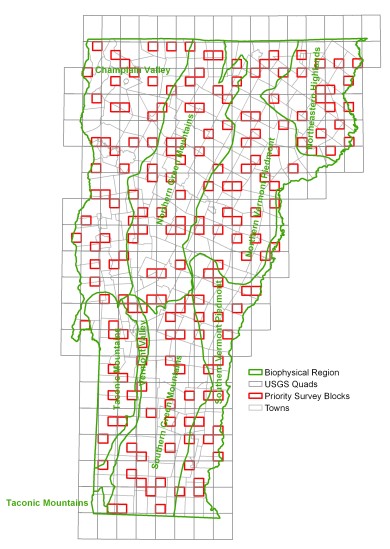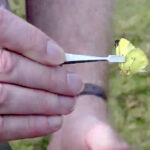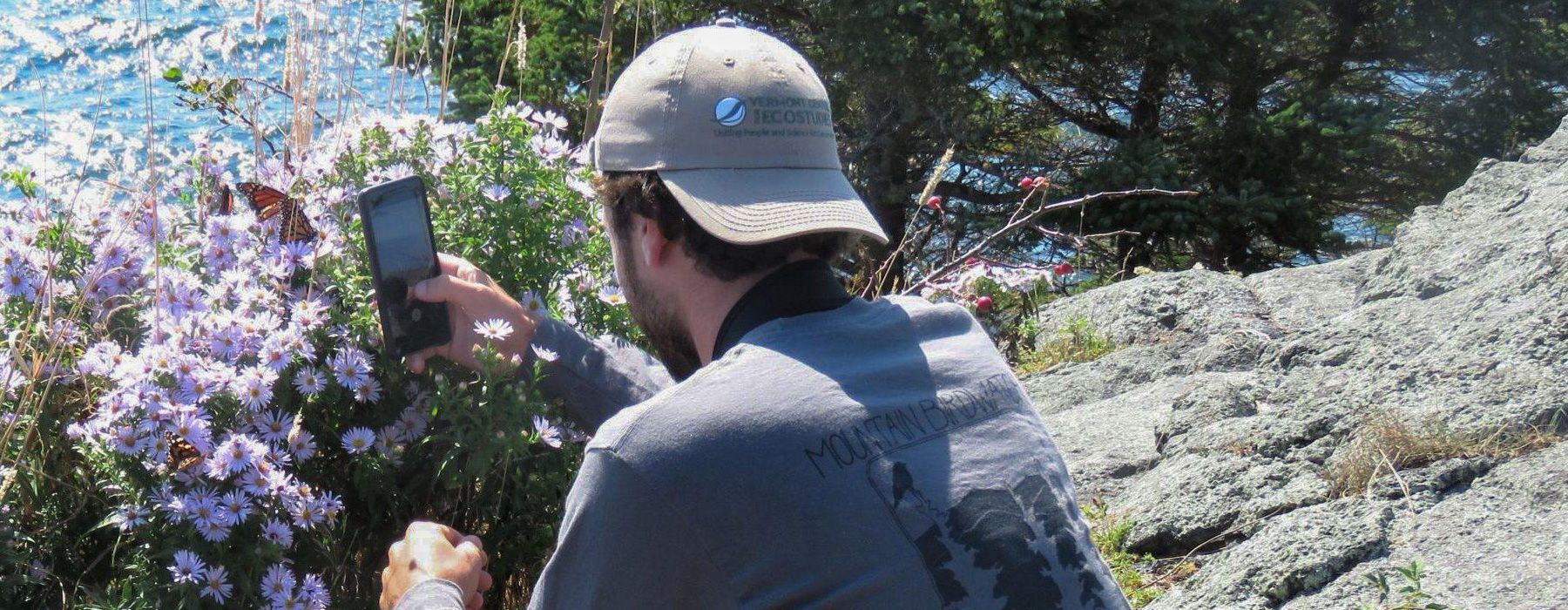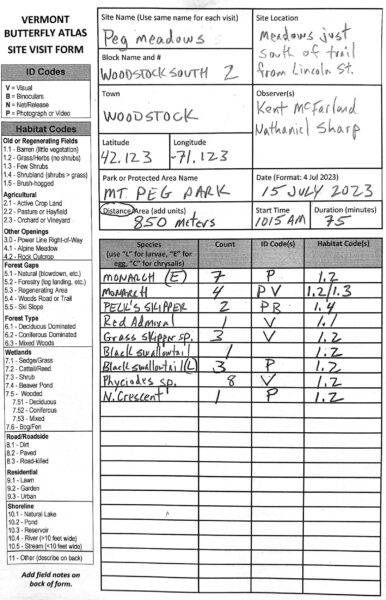From the common to the rare, we need your help in recording butterflies in Vermont. Everyone knows what a butterfly looks like and many of you are armed with a camera. Help us help the butterflies! Whether you help with full surveys or just find a few butterflies while doing other outdoor activities, It's easy to report your sightings to the Vermont Butterfly Atlas at e-Butterfly.
Joining the Vermont Butterfly Atlas is easy and you don't have to be an expert. Just follow these steps.
Step 1 – Join e-Butterfly and the Atlas Project
No matter what your participation level is, join e-Butterfly to upload your butterfly observations for the atlas. At e-Butterfly, you can add your valuable observations with just three easy steps:
-
- Map the location of you observation(s).
- Add information about your effort.
- Record your butterfly counts and upload your images.
Check out our Quick Start Guide to e-Butterfly and join the atlas project at e-Butterfly to see all the latest checklists and observations for the project. You can also join our Atlas discussion forum at e-Butterfly, a place for everyone to share ideas, learn from each other, and more.
Step 2 – Watch the Atlas Training Video
We have a recorded video workshop that you can watch anytime to help you learn how to survey butterflies for the atlas and more. This is an important step to help jumpstart your atlasing efforts.
Visit our events page to find any upcoming public field trips or webinars.
Step 3 – Find Butterflies and Report Your Observations
Option 1: Incidental Butterfly Encounters
This option allows you to document butterflies whenever you see them no matter where you are in Vermont. You can report a butterfly presence whenever and wherever you are–during a visit to a park, for example, walking your dog, in your garden, on a hike, or even on your way to work. These can be more spontaneous encounters with butterflies that you add as Incidental Observations in e-Butterfly (preferred) or to the Vermont Atlas of Life project at iNaturalist. Even if you don’t know what species of butterfly you saw, if you upload your photographs of the butterflies you find, we have computer vision that will help you get an identification immediately, and then our experts will also review your photographs.
Option 2: Complete Butterfly Checklists Surveys
A butterfly checklist consists of spending at least 15 minutes completing one of the following types of surveys at a place of your choice:
- Traveling Survey- You walked a specific distance. If out and back, record the distance one-way. Keep track of distance using a smartphone app, measure on a map like Google Maps, or other relatively accurate method.
- Area Survey- You surveyed a defined area, often performed when covering the same ground repeatedly during a specific amount of time, such as a small meadow.
- Timed Count- A survey in which you recorded your time, but you don’t know the size of the area or distance traveled.
- Point Count- You are at a predetermined place to spend a fixed amount of time observing and recording all butterfly species seen within a defined radius of your position. An example of this might be a small pollinator garden or a small patch of wildflowers.
These are called “complete checklist” surveys. You are counting every butterfly you find, even if you can’t identify it to species, and adding it to your list. Once your checklist survey is complete, you can enter your data at e-Butterfly.org. Learn more about checklist surveys below.
 Option 3: Adopt an Atlas Block to Survey Completely
Option 3: Adopt an Atlas Block to Survey Completely
This is perhaps the most meaningful way to contribute to the atlas. This option involves you adopting one or more specific survey blocks to visit regularly from spring through fall in an attempt to record all the butterfly species that may be present in the block. Don’t worry, you have several years to fully survey a block during the atlas!
Currently, we consider a block to have enough surveys completed when it has recorded 40 or more species. For some blocks that are heavily wooded, that won’t be possible.
The atlas seeks butterfly records from anywhere in Vermont – your front yard, a park, or a remote spruce bog. But to make sure we survey butterflies evenly and systematically across the state, the project has adopted a grid mapping system. The system relies on the 184 U.S. Geological Survey 1:24,000 topographic maps (“7½-minute maps”) that cover Vermont. We’ve divided each of these maps into six blocks of equal size (roughly 3 miles x 3 miles) and numbered them 1 to 6. That’s a total of 1,104 survey blocks (184 maps x 6 blocks per map = 1,104 blocks).
Since we don’t have the person-power to sample for butterflies in each and every block, the atlas has randomly selected 184 of these blocks (one per USGS map) for the focus of our work. We call these blocks “priority blocks” (you’ll be hearing a lot about them). The 184 priority blocks make up a representative sample of the Vermont landscape; they’re the minimum number of blocks that must be surveyed in order to obtain a statistically valid sample of butterflies for the entire state. They’re the same blocks that were used for the Vermont Breeding Bird Atlases.
At a minimum, we need to completely survey butterflies in each of the 184 priority blocks before the end of the atlas. We would like you to first focus on adopting and surveying these priority blocks.
This requires three basic steps:
1. Adopting a survey block(s) using our Atlas Block Mapper tool.
Become a primary observer for any survey block(s) you wish to adopt by visiting our mapping tool and signing up. You can zoom into the region you are interested in surveying to view the blocks more closely. Then click on a block of interest and select the sign-up link to fill out a form and instantly claim the block. You can also explore data, download a species checklist for the block and more. Remember: we would like you to focus first on adopting and surveying priority blocks first. But like us, if your home falls within a non-priority block or there is one you visit all the time for other reasons, please do adopt those non-priority blocks too if you’d like.
2. Visiting site(s) throughout your adopted survey block from spring to fall to document as many butterfly species as possible using one of the e-Butterfly survey protocols.
Selecting Survey Sites: Once you’ve chosen or been assigned a block and have a map, you are ready to choose specific Survey Sites within that block. Before visiting a block look over the map and note the location of forest openings and other potentially sunny areas; these tend to have higher butterfly diversity. A survey site is generally defined as an area of similar habitat bound by physical features. Potential sites include: wetlands, overgrown fields, flower gardens, woodland clearings, wide woods roads or trails, and recreation paths. Some blocks may offer only a few potential sites, others many more. Don’t feel you must survey every potential site within a block. Try to select different habitats for each. It’s best to visit various sites and habitats because you will find a greater diversity of butterfly species.
3. Conducting Checklist Surveys This is the heart of your survey work. (It’s also the fun part.). See below.
Completing Butterfly Checklist Surveys
You should spending at least 15 minutes at a minimum completing one of the following types of surveys. These are called “complete checklist” surveys. You are counting every butterfly you find, even if you can’t identify it to species, and adding it to your list.
Types of surveys
- Traveling Survey- You walked a specific distance. If out and back, record the distance one-way. Keep track of distance using a smartphone app, measure on a map like Google Maps, or other relatively accurate method.
- Area Survey- You surveyed a defined area, often performed when covering the same ground repeatedly during a specific amount of time, such as a small meadow.
- Timed Count- A survey in which you recorded your time, but you don’t know the size of the area or distance traveled.
- Point Count- You are at a predetermined place to spend a fixed amount of time observing and recording all butterfly species seen within a defined radius of your position. An example of this might be a small pollinator garden or a small patch of wildflowers.
You should try to:
- Pick a Nice Day– Butterflies are solar-powered creatures, They’re inactive and very hard to find on cold, rainy, heavily overcast or extremely windy days.
- Go as Often as You Can– Since different butterfly species are active during different periods of the year (we call these “flight periods”), try to make regular trips to your survey site(s). Every two to three weeks from late April through October would be ideal. If you spread visits to a given site over more than one year, go at different months each year so that you’ll cover all potential flight periods. You can use our weekly Flight Chart to see which species may be flying each week in Vermont.
- Get Permission– Consult the landowner before visiting private property. If you explain the atlas, you’ll probably get permission to visit (maybe they will even join you!). Some private land – reserves owned by The Nature Conservancy, for example – are fragile and require permits or permission to visit. When in doubt, contact the atlas coordinator with your questions.
During Your Survey
If it is helpful, you can use an optional Site Visit Form to record information about your site (site name, site location, date of visit, time at the site, etc.) and to keep a count of the butterflies you find. The Site Visit Form allows you to describe a site and note all butterfly species you encounter there. Complete a separate form every time you visit a site. Download a PDF of the Site Visit Form to print and use.
Field Tip! Fill out the top of the form before you begin your survey and then photograph it. All the images of butterflies after that belong to that survey. When you are finished, complete the form and photograph it again to signal the end of the survey on your camera roll.
Record and share your zero checklists too!
It definitely happens, especially in spring. It is a perfectly sunny day and you just can’t turn up a single butterfly. It seems like a wasted effort, but it isn’t. Zero counts are important too! We want to know where and when you find no butterflies. Simply add a checklist to e-Butterfly as normal, but for species, add the name “Butterfly (SUPERFAMILY Papilionoidea)” in the species box and add a 0 to the count box. Answer yes to the question at the bottom and submit it. Here’s an example from a spring count. Zeros are data too!
Verifying Butterflies During a Site Visit
As you survey for butterflies, your objective is to obtain the strongest defendable evidence for each species. The atlas recognizes three ways to document butterfly presence as you search a site: Visual Identification (a butterfly sighting), or photographic vouchers. Even common and easily identifiable species should be photographed if possible when you complete a survey.
Visual Identification: The most important thing about a visual identification is that you must be absolutely sure you have identified the butterflies correctly. That’s because the atlas has no way of verifying these sightings. Identification by sight can be difficult or impossible for some species. Or an individual butterfly may be positioned in a way making identification challenging or even impossible. Knowledge of key field marks and distinguishing features are always critical. We highly recommend studying and using your butterfly field guide. If you can only identify it as, say, a skipper, one of the Phyciodes crescents, or one of the “lady” species (Painted Lady or American Lady), for example, then indicate that on your checklist. It is fine to count things at higher taxonomic level, such as family or genus, than species. In fact, it often happens!
Photograph Voucher: A photograph is the best way to document a butterfly’s presence. Photo vouchers are important for larvae, pupae, and adults. You can also use video. It is then possible to use a smartphone or computer app to save frame(s) as still photographs to upload with your checklist survey on e-Butterfly. Some find that doing this gives them a better chance to get photographs with the best view of field marks. Unfortunately, due to the size of video, e-Butterfly does not accept video at this time as a voucher.
Survey Equipment:
- Close-focusing binoculars- Though butterflies can be enjoyed without any special equipment, a good pair of binoculars can enhance your ability to see subtle features from a short distance. They key is focal distance. It helps if the binoculars can focus as close as the ground just in front of your toes while standing. There are many that might work fine. One that we like and under $150 are the Pentax Papillio.
- Digital camera- Many of us carry a smart phone with a camera, and often, that is all we need. Especially if you are capturing, photographing, and releasing butterflies. The advantage is that is is right in your pocket and it saves the location with gps. You might find that they are difficult to use for wild adults, especially small species. You have to get fairly close to get a good shot, which often results in the butterfly taking flight. Many butterfly watchers add a good compact digital camera that has both a macro (close up) feature and an optical zoom lens. Here’s a good overview from Bryan Pfeiffer. Finally, some of you may have full-frame digital SLR cameras that work wonderfully with a longer lens.
 Butterfly net- We have not found a good supplier since the Bioquip, the go to place, retired. We are working on it. But these nets might be okay from Home Science Tools, and they are inexpensive.
Butterfly net- We have not found a good supplier since the Bioquip, the go to place, retired. We are working on it. But these nets might be okay from Home Science Tools, and they are inexpensive.- Butterfly (aka Stamp) forceps- These are used to gently grab a butterfly from a net to then photograph it before releasing it. The wide, spatulate tongs allow you to grip the butterfly’s closed wings near the leading edge.
Enter your data and upload your photographs to e-Butterfly.
At the end of each day of butterfly surveys, enter all of your data and photographs into e-Butterfly. Try not to wait on this step. It is better to prepare your images and enter your data as soon as possible while it is all still fresh in your mind. Check out the e-Butterfly quick start guide.









